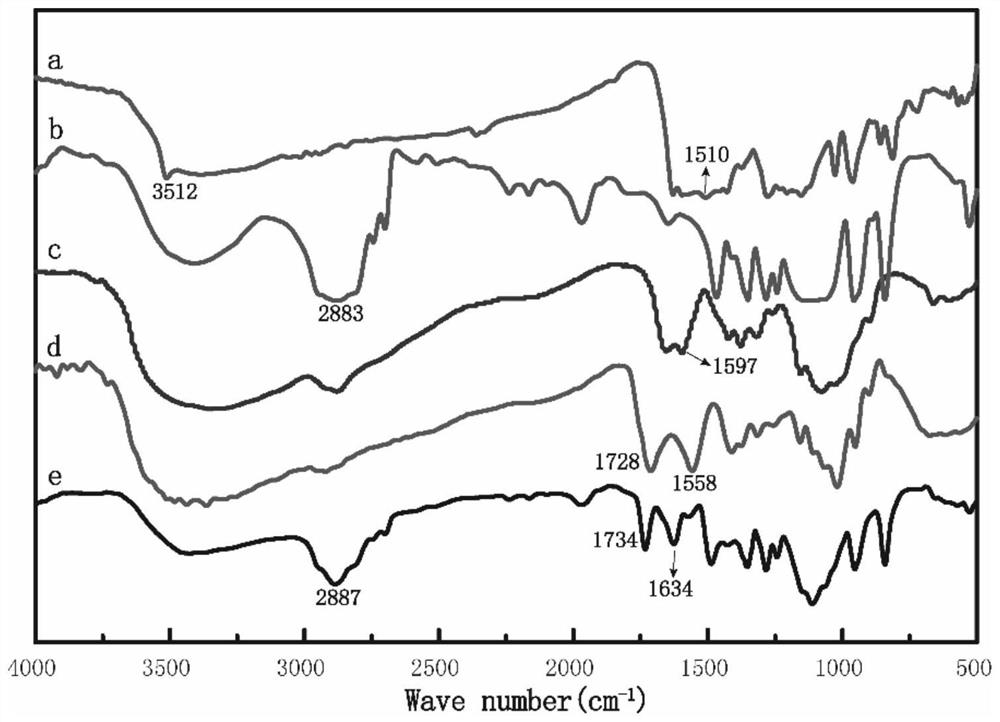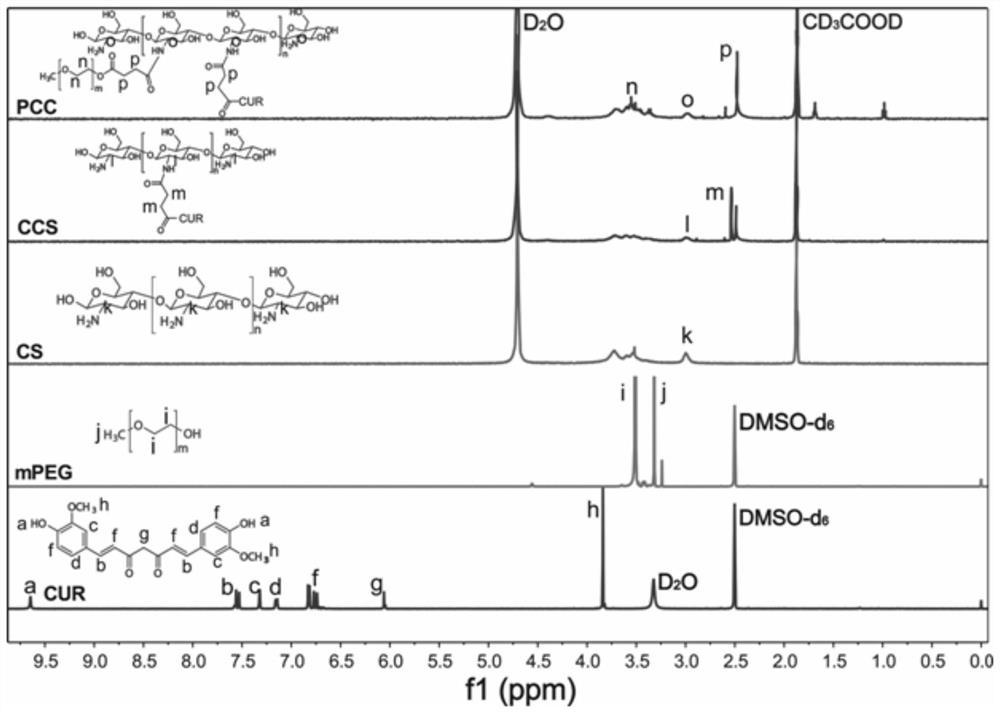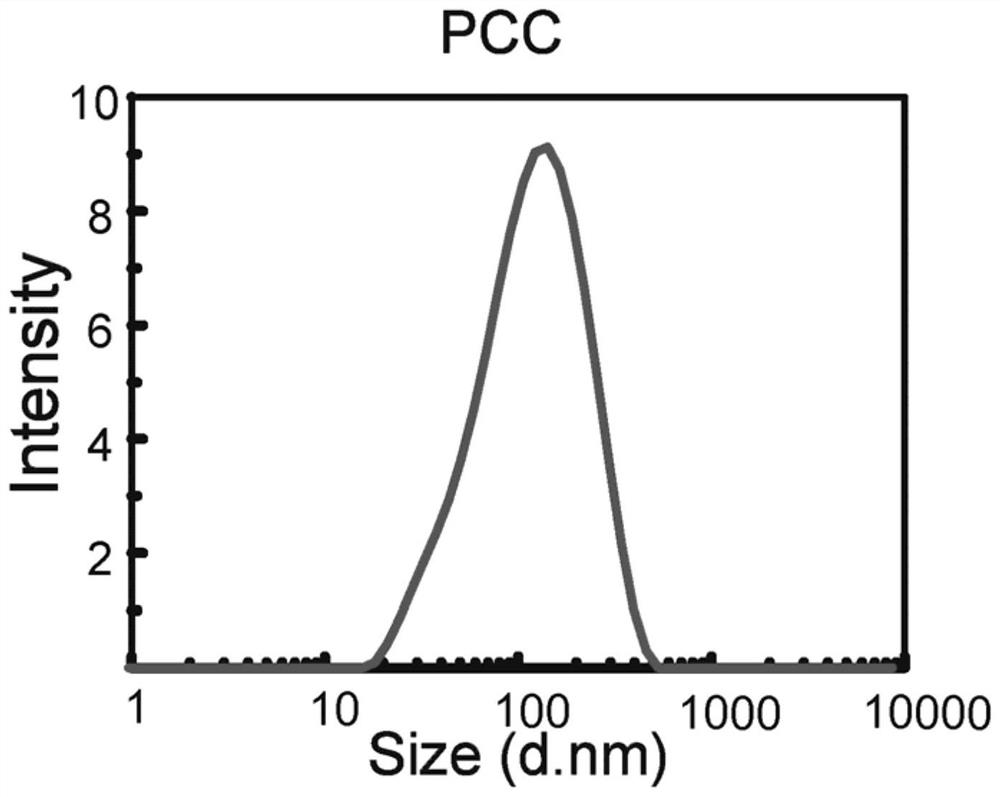Polyethylene glycol-chitosan-curcumin polymer, and drug-loaded nanoparticles and preparation method thereof
A chitosan polymer, polyethylene glycol technology, applied in nanotechnology, pharmaceutical formulations, nanotechnology and other directions, can solve the problem of not being able to prevent the partial release of curcumin
- Summary
- Abstract
- Description
- Claims
- Application Information
AI Technical Summary
Problems solved by technology
Method used
Image
Examples
preparation example Construction
[0045] A preparation method of polyethylene glycol-chitosan-curcumin polymer, comprising the following steps:
[0046] Reaction of curcumin with succinic anhydride produces carboxylated curcumin.
[0047] After the carboxyl group of carboxylated curcumin is activated, it reacts with chitosan solution to generate curcumin-chitosan polymer.
[0048] After the carboxyl group of carboxylated polyethylene glycol is activated, react with the acetic acid solution of curcumin-chitosan polymer under a protective gas atmosphere for 48h to 96h, and purify to obtain polyethylene glycol-chitosan-curcumin polymer.
[0049] A kind of polyethylene glycol-chitosan-curcumin nanoparticle provided by the invention is to take polyethylene glycol (mPEG), succinic anhydride (SA), chitosan, curcumin as raw material, and the molar ratio is 1:1.2 The reaction of curcumin with succinic anhydride first synthesizes carboxylated curcumin (CURS), and in the presence of a catalyst, the carboxylated curcumin...
Embodiment 1
[0062] Embodiment 1: the chemical synthesis of polyethylene glycol-chitosan-curcumin polymer (PCC)
[0063] Its synthetic route is:
[0064]
[0065] 1) Synthesis of curcumin-chitosan (CCS) polymer
[0066] 2g (5.4mmol) of CUR, 0.65g (6.5mmol) of SA and 0.66g (5.4mmol) of DMAP were dissolved in 20ml of DMSO, and the reaction was stirred at 50-60°C for 48h. The reaction solution was dripped into 100ml of cold diethyl ether, stirred while dripping, and a yellow precipitate was precipitated, filtered by suction, washed with 50ml of cold diethyl ether each time, and carried out three times. The obtained yellow solid was vacuum-dried at room temperature to obtain pure yellow CURS. Dissolve 0.72g CURS and 0.20g DMAP in 10ml DMSO and stir at room temperature for 2h to activate CURS. Weigh chitosan 1.0g and dissolve in 10ml of 1% acetic acid aqueous solution (the molar ratio of CURS to chitosan unit is about 1:4), drop the activated CURS reaction liquid into the chitosan solutio...
Embodiment 2
[0069] Example 2: FTIR Spectroscopy of CUR, mPEG, CS, CCS and PCC Polymers
[0070] Take a small amount of solid CUR, mPEG, CS, CCS, and PCC and mix them evenly with infrared-dried potassium bromide powder (mass ratio is about 1:200), grind them carefully, press them into a transparent sample film, and place them in an infrared spectrometer to measure infrared spectrum.
[0071] FTIR spectra of (a) CUR, (b) mPEG, (c) CS, (d) CCS and (e) PCC polymers are shown in figure 1 . with CUR( figure 1 a) and CS ( figure 1 b) Compared to CCS ( figure 1 The infrared spectrum of c) maintains the characteristic absorption peak at 1558cm-1, which comes from the N-H bond of -NH2 at 1597cm-1 in CS, and a stronger peak appears at 1728cm-1, which is The C=O bond stretching vibration peak in the ester bond formed between CUR and CS indicates the successful esterification reaction between CUR and CS. In PCC ( figure 1 In the spectrum of e), the C=O stretching vibration peak of the amide bon...
PUM
| Property | Measurement | Unit |
|---|---|---|
| particle size | aaaaa | aaaaa |
| particle size | aaaaa | aaaaa |
Abstract
Description
Claims
Application Information
 Login to View More
Login to View More - R&D
- Intellectual Property
- Life Sciences
- Materials
- Tech Scout
- Unparalleled Data Quality
- Higher Quality Content
- 60% Fewer Hallucinations
Browse by: Latest US Patents, China's latest patents, Technical Efficacy Thesaurus, Application Domain, Technology Topic, Popular Technical Reports.
© 2025 PatSnap. All rights reserved.Legal|Privacy policy|Modern Slavery Act Transparency Statement|Sitemap|About US| Contact US: help@patsnap.com



